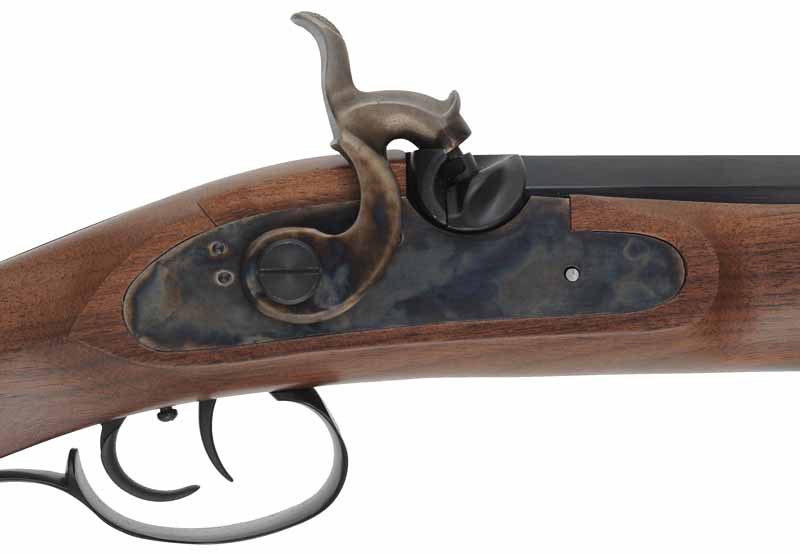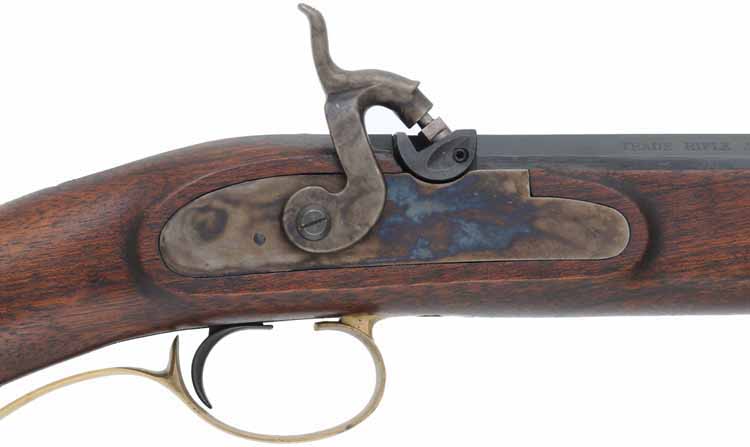user 36911
50 Cal.
- Joined
- Jan 31, 2020
- Messages
- 1,146
- Reaction score
- 1,017
The new GPR built by Pedersoli looks like this.





That snail is what I was refering to. It looks like someone sawed it off with a hacksaw? It looks nothing like my Ithaca Hawkin?The new GPR built by Pedersoli looks like this.

The one I had looked exactly like the one in your picture. I only disliked the snail. I could live with everything else. The rifle was very accurate had sleek lines and was overall well built. You mentioned the wood? What do you mean?Neither does the wood.
Which one is right?










That is fascinating! Really good stuff!@MtnMan
You are right about the position of the tang screws. The long tang by itself, with the screws through the wrist, certainly provides reinforcement. The trigger bar or plate on the original, classic Hawken rifles was one piece, extending from ahead of the trigger guard bow to back of the scroll. Both tang screws engaged the trigger bar, although as you pointed out, the screw visible in the scroll was not one of them. The full length, one-piece tang and the full length one-piece trigger bar made a "sandwich," with the wood in between, to give maximum reinforcement. You can see the full-length trigger bar in the exploded view of the Pedersoli Rocky Mountain Hawken in an earlier post.
@Kansas Volunteer,
I'm not sure we are talking about the same book. There were a number of guides and handbooks for emigrants published in the mid-19th century. One of the most famous was by a writer named Ware, who had never crossed the plains. He based his book on John Fremont's reports from his various and frequently disastrous expeditions in the 1840's. There were certainly Englishmen on the plains who wrote books about their experiences, notably George Frederick Ruxton and William Drummond Stewart, not to mention a number of English, Scottish, and Irish travelers who crossed the Canadian plains. I would be interested in knowing which writer was referenced in your post.
Captain Randolph Marcy (1812-1887) was a very highly respected career military man who traveled all over the west. His book, The Prairie Traveler, was published by the War Department of the US Government in 1859. I have never heard this book described as anything but a primary reference. It was definitely written by Marcy, based on his personal experiences, of which he had many. The book was written while Captain Marcy was working for the Department of State in Washington. After the book was published, he was promoted to major. It is also a great read. I have a copy I bought about forty years ago, and I still enjoy reading it. Marcy had a lot to say about firearms. This is the quote to which I referred earlier, discussing "Hawkins" rifles:
View attachment 77711
Not exactly good advertising for the Hawken brothers, but it does reinforce the point that many of the old plainsmen, like Tom Tobin, held on to their muzzle-loaders to the end.
Regarding Tom Tobin's Biringer (or Birringer) rifle, I don't know for certain where it is, but I would suspect it is in Colorado. Tobin died in 1904, and he was buried in the Fort Garland cemetery. Lt. Col. Goodwin's article (you can link to it RIGHT HERE) was published in 1997, and at that time Tobin's Birringer rifle was owned by a Mr. Charles Mondragon of San Luis, Colorado. That was 24 years ago, though. If I wanted to find it, I would try calling the Fort Garland Museum as well as the San Luis Valley Museum in Alamosa, Colorado, which evidently has an exhibit in remembrance of Mr. Tobin. The museum has a little PDF about Tobin online (click HERE) that shows a rifle on display, but I don't think it is the Birringer rifle Col. Good win described.
However, John Biringer was evidently a prolific builder, and there are a number of his rifles "out there," in displays as well as up for sale on the various auction sites. I've found several, just poking around on the web, and all I've found have a lot of similarities. Some have one barrel key, while some have two, and some have back action locks while others are front-action or "bar" locks. Most seem to have brass mountings, although the one described by Goodwin was trimmed in iron. Some are small-caliber, but various sources state Biringer also made "fifty caliber" rifles, like the one Goodwin described. I thought it was interesting that the article about Biringer on the Kansas State Historical Society (KSHS) website showed a stock pattern or template, as all of the rifles I've found online had similar architecture. Also, they all seem to be half-stocks with ribs under the barrel. This one is from the KSHS article:
View attachment 77712
You might even contact the KSHS to see if they have this rifle on display somewhere in the state.
Next is a nice one with one barrel key I found on an auction site:
View attachment 77713
This illustration was in a publication I found online, entitled Plows and Bibles, Rifles and Revolvers: Guns in Kansas Territory :
View attachment 77714
The Sharps is a Model 1853 and the shotgun appears to be percussion, so we should be in compliance with forum guidelines. The bottom rifle is evidently by Biringer.
I think it would be great if you had a copy of a Biringer rifle built. If you can find one in Kansas and get some photos, or use photos found online, then contact a builder like John Bergman or Mike Roby to build a reproduction, you would end up with a really nice, shootable "non-Hawken" plains rifle with a Kansas connection.
One final historical footnote of interest: John Biringer founded a hardware store in Leavenworth in 1859. He was still running the business in 1900, when he hired a young, apprentice blacksmith named Hoyt Heath Buck. Mr. Biringer taught the young Mr. Buck the art of heat treating steel, in addition to general blacksmithing skills. The young man learned his craft well, and went on to found his own cutlery company: Buck Knives.
Best regards,
Notchy Bob
I think it's a very nice Hawken re-make, but I can't say who made it. Are there any makings on the barrel(s) other than the caliber designation and the "Black Powder Only" graffiti? It appears to have the Griffith Tool Company breechplug and "comma" shaped snail, as on original J&S Hawkens. I'm not sure what to make of the trigger guard, which is a much thicker, heavier casting than you normally see, especially at the top of the scroll. The triggers, too, seem a little unusual. The front trigger has a subtle curve, and the small "web" at the back of the front trigger may be unusual enough to help identify it. I like the dark finish, which I believe is very authentic. I think on originals the wedges or barrel keys typically went in from the left, with the heads on the side opposite the lock.Since were talking "hawkins" old and new (including styles) what you think of this poor restoration? Not sure of any of it and still being finished and was assembled around a from a stripped stock at an estate sale and various bits and pieces from everywhere. View attachment 77702View attachment 77703View attachment 77704View attachment 77705View attachment 77702View attachment 77703
Yes! That is what I was refering to. My Lyman shot well and accuracy was amazing. It was pleasant to shoot as you knew when you pulled the trigger that the ball would go where you aimed. What was agravating was when ever I handled the rifle my mind would be drawn to that cut off snail? That is why I sold it. I should say gave it away as I got $200.00for it and it was almost brand new! I was stupid!Does this look right to you?

Just look at the pictures of the two rifles you said." like this"? one snail was flat on the side the other was gracefully curve like the original ones I have seen? The flat sided one looks like it was cut off!LME...........To be honest. I'm not sure what you mean by cut off snail?


Short answer i assembled it. Found gorgeous stock at gunshow. No barrel, lock ect. I thought it was an original and bought for what is now low pocket change. The finish on it is ACRAGLAS!!!!, The absurdly low cost, figure and style made me buy it. At another show i found two, Brand new, Unused, plugless Browning MTN rifle barrels. A .54 and a .45 . Had sights but thats it. I think they were stock parts from after the rifles were discontinued. You are 100% correct about the Griffith plugs, tangs and lock. Stock was originally inletted for them so a no brainer. Triggers, guard and misc came from shop parts drawers. The underrib, thimbles, under logs came from shop stock and made on my lathe and milling machine. Shoots dead on with either barrel but very heavy for these old arms with the .45 barrel. When finished it will be cased as a 2 barrel set with accoutrements.I think it's a very nice Hawken re-make, but I can't say who made it. Are there any makings on the barrel(s) other than the caliber designation and the "Black Powder Only" graffiti? It appears to have the Griffith Tool Company breechplug and "comma" shaped snail, as on original J&S Hawkens. I'm not sure what to make of the trigger guard, which is a much thicker, heavier casting than you normally see, especially at the top of the scroll. The triggers, too, seem a little unusual. The front trigger has a subtle curve, and the small "web" at the back of the front trigger may be unusual enough to help identify it. I like the dark finish, which I believe is very authentic. I think on originals the wedges or barrel keys typically went in from the left, with the heads on the side opposite the lock.
Is that rear sight adjustable for elevation?
I'm not sure I fully understand the comments that accompany the photos. Did you assemble the rifle from parts? Do the photos show it before or after refinishing?
In any event, I think it is a fine Hawken-style rifle. I've no idea who made it, but it's one I would be very pleased to own.
Notchy Bob
Enter your email address to join: